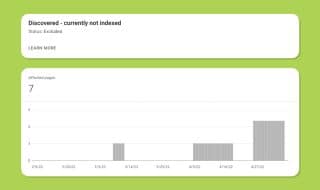What's The Best Way to Reverse Blog Content Decay?

There's an interesting dichotomy with the internet.
On the one hand, studies have shown that the average age of content in the top ranks of Google's search results is somewhere in the 2.5-year range. Older content builds up value over time. Sites build up content and value and grow in ranking, reputation, traffic, and profit.
On the other hand, the older a piece of content is, the more likely it is to have some kind of flaws or issues. Exceptionally old content degrades over time until it's potentially no longer relevant.
Running a blog often feels like it's all about producing new content, but maintaining the content you have is also a big part of it. It's something I do a lot of for my clients and even for myself.
Let's talk today about blog decay and what you need to do to reverse it.
A Rundown on Blog Decay
Let's start with the basics: what is blog decay?
Blog decay is entropy - the deterioration of your content over time.
It's not like other forms of deterioration. It's not like your blog posts are going to get more brittle and prone to snapping because of UV exposure, or the ink will fade because of light, or the organic material risks rotting. That can happen to the physical devices that store your site but not to the data on it.
Content decay occurs slowly over time, and it can happen for a variety of reasons. The primary symptom is a loss of traffic; a blog post that used to bring in 10,000 sessions per month is now bringing in 9,000, then 8,000, and so on.

What causes blog content decay, though?
- Link rot. When the links you include to other sites start to no longer work, they can end up redirected to irrelevant pages, redirected to parked domains or spam sites, or just land on 404 pages, all of which are tiny hits to the value of your page.
- Declining interest in the topic. Different kinds of topics lose interest at different rates; news posts are made irrelevant in days or weeks, while evergreen content can be mostly stable for years, but everything eventually degrades. I have a whole post on different kinds of content and how fast they deteriorate here.
- Newer versions of the resource on your site. Sometimes, you write about a topic and don't realize it's something you've already covered; your newer, ideally better version might siphon some traffic, ranking, and interest from the older post.
- Changes to user search intent. Sometimes, topics change over time; a good example is solar panels. Years ago, solar panels were rare and expensive enough that most people searching for them would be looking for information for papers and research; now, it's more likely to be about purchasing or home installation.
- Changes to Google's preferences. It's no secret that Google's standards have incrementally gone up since the big Panda update back in 2011; what used to be a great post might end up looking mediocre a few years down the line.
- Changes to Google's search results. Different kinds of enhanced results have created new opportunities for your content to be featured, but older content might not be written or formatted in a way to take advantage of them.
There are also external factors. Link rot can also occur to the links pointing to your blog, rather than from it. Losing incoming links because another site purged content or removed their site entirely is another form of decay.
On the flip side, your posts can deteriorate over time just because more and more competition crops up for the same topic, and they're able to look at what you wrote and use it as a springboard. I often talk about "doing what the competition is doing, but better" as a blogging strategy. Unfortunately, other people do the same thing to you.
So, if this is all what causes blog content decay, the next question is: how do you deal with it?
How to Address Blog Content Decay
Dealing with blog content decay isn't terribly difficult in most cases. The problem is that it takes time and effort, it can't really be done automatically, and it's a task that grows the larger and older your site becomes.
Determine Where to Focus Your Efforts
The first thing you need to do is figure out where you want to focus your efforts when it comes to blog content decay.
Start by making sure you're tracking relevant data. The most important metric is generally incoming traffic, but search rankings, links pointing to the post, and other related metrics can be important as well. There are a variety of SEO plugins like AIO or rank trackers that can help watch it all for you, and some can even alert you if your content is slipping.

Next, pick content to prioritize. I generally think there's a sweet spot for post maintenance. You want to find posts that are on the decline. Your top-performing posts? They might need maintenance eventually, but maybe not yet. Posts that are already dead in the water? Chances are there's not much you can do for them. Posts that were doing well but are slipping? There's your sweet spot.
This gives you the list of posts that are on the decline, and you can start to look for ways to fix them. Figure out why they're faltering, and take the relevant action.
Do an Internal Factors Audit
This is my informal name for a review of the blog post to look for reasons why it's decaying, which are things you can fix with a relatively small amount of effort.
- Check for link rot, especially links that aren't overt 404s but aren't relevant anymore.
- Check for dated information or references that can be updated. This can be as simple as updating a title from "the top X of 2024" to 2025.
- Check for ways to optimize your pages, like smushing images for speed.
- Check for quick opportunities for rephrasing or optimizing content.
- Check for new keywords you can add or old keywords you could remove.
- Check for opportunities to add Schema markup to your post.
- Check for opportunities for other post enhancements, like a table of contents.
- Check for typos, misused words, grammatical errors, or other issues you didn't notice before.
At the same time, you can look for reasons why your content might be decaying that would take more effort to fix. If these are relevant, you can set the post aside in a bucket of "do this later" tasks for when you have more dedicated time.
- Check for other content on your site cannibalizing your keywords or topics.
- Check for other content on your site that you could use to revamp into a content cluster.
- Check to see if your content trips AI checker flags, and try to fix it so it doesn't.
There's a pretty good chance you're going to find a few smaller issues you can correct, but also that those issues won't actually stop blog content decay. That's when you need to look for external factors and evaluate the space.

If you have the opportunity to address the low-hanging fruit, do so. It's pretty easy to fix some links, do a once-over for keywords, or slap in some Schema using a decent plugin. You can also run your post through your promotion engine again; submit it to social media, include internal links in new fresh content, that kind of thing.
Just because they probably aren't going to reverse blog post decay doesn't mean you shouldn't take action when you see it.
Check External Causes of Blog Content Decay
External factors are the most common reasons your content is decaying.
By far, the #1 reason is newer or better competition. Maybe an existing competitor is revamping a post you were outranking, and now they outrank yours. Maybe a new site covered the topic. Maybe a big site covered the topic.
You can fight competition in a lot of different ways, but the specific options you use can vary depending on the topic, the scale of the competition, and the extent of the changes you'd need to make to do it.
Sometimes, it might necessitate a complete rewrite of the content. Other times, it might mean you have to create entire new blog posts for supporting content to pillar it up. This isn't bad; it's just a lot of work.

In other cases, it's easier. Maybe you just need to use some new keywords, as the cultural zeitgeist surrounding a topic has shifted in the way they talk about it. Maybe you can add a few paragraphs throughout the posts and spruce them up into better working order. These are more work than something like fixing links, but better than having to rewrite an entire post from scratch.
In some cases, your blog posts are just falling out of date in a way that will take work to re-do. This is frequently what happens with case studies; people create them under the assumption that they'll be evergreen, but more than a couple of years out, the data loses relevance, so you need to re-do the whole study with more updated data. If you do, it can be extremely powerful for link and value building, but it's also a tall order.
I find that most instances of blog decay need at least a mid-level amount of effort to fix. You might be adding 400-500 words of fresh content, revamping half of the post, or retooling the information you provide for a better flow. That's why it ends up being a lot of work.
Know When to Walk Away
Some blog posts are decaying in a way that isn't easily addressed. Worse, they might not actually have enough value to be worth trying to salvage. Old posts with no real incoming traffic might be worth a purge or can just be ignored.
To me, the deciding factor is usually whether or not the post has incoming links. Links can still have value even if they don't pass traffic, and getting rid of a post that has decent incoming links can be harmful. It's why content pruning needs to be done with care.

On the other hand, if you find old posts from when your site was small, with no links, no traffic, and no real value, you can usually safely get rid of them.
Can Blog Content Decay Be Prevented?
No. The internet is an ever-evolving morass of information. There's no way for you to algorithmically or automatically keep your content up to date, and if you remain static, the churn of the world around you will move past you.

That said, you can take actions to try to forestall decay and address it before it gets bad enough to need major retooling.
- Use automatic tools to monitor things like links for validity and even update dates automatically.
- Set a schedule to review old blog posts 6-12 months after they're published to look for opportunities.
- Be as thorough as possible with internal links. I find internal link recommendation tools can help by suggesting opportunities you might not remember you have.
- Be as proactive as you can with building backlinks to a variety of content.
The fact that keeping content up to date and refreshing it to keep decay at bay is a ton of work is why my first piece of advice was to prioritize. If you try to keep every blog post you've ever written up to date, you'll very quickly find it's unsustainable. If you limit it to just the top 20% or so of your posts that were good but are declining, then you have a smaller workload. An endless workload, to be sure, but a smaller one.










Comments